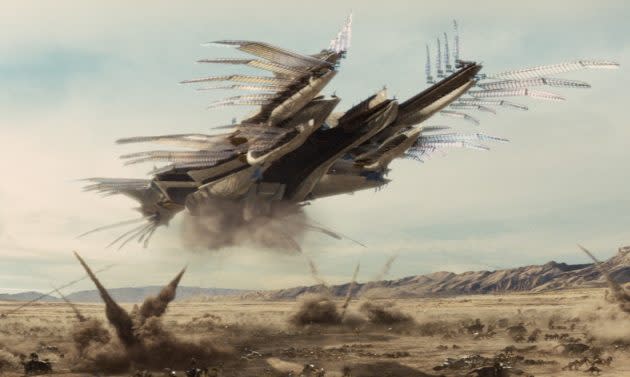NASA funds ideas from science fiction

Truth can be stranger than fiction, but it shouldn’t be strange to hear that NASA spends millions of dollars on efforts to turn science-fiction concepts into true technologies.
The NASA Innovative Advanced Concepts program, also known as NIAC, has been backing far-out aerospace concepts for almost 20 years. It started out as the NASA Institute for Advanced Concepts, modeled after the Pentagon’s DARPA think tank.
NIAC’s latest crop of 22 tech projects was announced this week, and they include a few concepts that were virtually ripped from the headlines of science fiction’s pulp magazines. Here are our favorite five:

Flying airships of Mars: The idea of sending airships floating through the Red Planet’s skies dates back to Edgar Rice Burroughs’ Barsoom novels of the early 20th century.
One big problem: Mars’ actual atmosphere is so thin that an airship would have to maintain a vacuum to become buoyant. That’s exactly what Georgia Tech’s John-Paul Clarke intends to do with an experimental double-shelled, reinforced vacuum airship.
Maybe he should call it an “airless-ship.”

Bioengineered bugs for Mars: To transform the Red Planet from a cold, lifeless world to something greener, astronauts lay down a layer of bioengineered algae in the 2000 movie “Red Planet.”
Berkeley’s Adam Arkin and his colleagues plan to look into bioengineering strains of a type of bacteria known as Pseudomonas stutzeri, with the aim of detoxifying the perchlorate in Martian soil and enriching it with ammonia. That’ll make it easier for Mars settlers to grow potatoes, like fictional astronaut Mark Watney did in “The Martian.”

Solar gravitational lens: Earthlings figure out how to use the sun’s gravitational field to focus light rays from the Milky Way galaxy’s distant frontiers in “Existence,” a novel by David Brin.
Slava Turyshev of NASA’s Jet Propulsion Laboratory will look into how a robotic probe sent to the far reaches of the solar system could actually use the sun as a gravitational lens to detect and study life on Earthlike planets up to 100 light-years away.

Artificial gravity: How do astronauts in space operas ranging from “Star Trek” to “The Expanse” keep their feet on the floor as the walk around their interplanetary spaceships? It’s challenging enough for real-life astronauts to keep their muscles and bones healthy in the zero-G conditions on the International Space Station.
Jason Gruber of Medical Solutions Group and his colleagues want to develop an unorthodox method to give astronauts a dose of artificial gravity during long-duration space missions: Their “Turbolift” system is basically an elevator that lifts and drops an astronaut for one-second bouts of 1G acceleration. “The experience is likely to be analogous to bouncing mildly on a trampoline,” Gruber says.

Fusion thrusters: Until the warp drive is invented, propulsion fueled by nuclear fusion is about the best we can do. Fusion power plants are built into fleets of fictional spaceships, including Discovery One in “2001: A Space Odyssey” and the starship Avalon in “Passengers.”
Several NIAC projects will look into fusion power and other unorthodox propulsion technologies: Check out the concepts from Michael LaPointe at NASA’s Marshall Space Flight Center, Raymond Sedwick at the University of Maryland, John Brophy at NASA’s Jet Propulsion Laboratory and Heidi Fearn at the Space Studies Institute.
Check NASA’s website for the full list of 15 Phase I projects, including ideas for asteroid-mining robots and solar-surfing probes.
Each of the Phase I projects is slated to receive up to $125,000 for a nine-month feasibility study. If those studies are successful, the teams can apply for Phase II grants, worth as much as $500,000, that are meant to support follow-up studies for two years.
NASA says five Phase II projects have been selected for the class of 2017:
Venus Interior Probe Using In-situ Power and Propulsion, Ratnakumar Bugga, JPL
Remote Laser Evaporative Molecular Absorption Spectroscopy Sensor System, Gary Hughes, California Polytechnic State University.
Brane Craft Phase II, Siegfried Janson, The Aerospace Corporation.
Stellar Echo Imaging of Exoplanets, Chris Mann, Nanohmics.
Automaton Rover for Extreme Environments, Jonathan Sauder, JPL.
Optical Mining of Asteroids, Moons, and Planets to Enable Sustainable Human Exploration and Space Industrialization, Joel Sercel, TransAstra.
Fusion-Enabled Pluto Orbiter and Lander, Stephanie Thomas, Princeton Satellite Systems.
NASA selects NIAC projects through a peer-review process that evaluates innovativeness and technical viability. The program is designed to support technologies in the early stages of development. Most of them are expected to require at least 10 more years of development before they’re incorporated into a NASA mission.